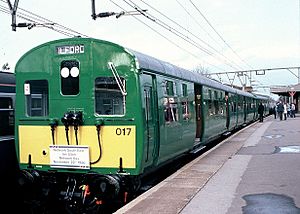British Rail Class 306 facts for kids
Quick facts for kids British Rail Class 306 |
|
|---|---|

The preserved Class 306 train (unit 017) as seen on the launch day of Network SouthEast. This view also shows the carriage which was not modified when the trains were converted from the dc to ac power supply system.
|
|
| In service | 1949 - 1980 |
| Manufacturer | Eastleigh Works |
| Number built | 92 trainsets |
| Formation | 3 cars per trainset |
| Operator(s) | British Rail |
| Specifications | |
| Maximum speed | 75mph (121km/h) |
| Weight | Total - 105 tons |
The British Rail Class 306 was a special type of train called an electric multiple unit (EMU). These trains were first used in 1949. Imagine a train that gets its power from electricity, and each part of the train can move on its own or be linked together. That's an EMU!
There were 92 of these trains, and each one had three cars or sections. They were built to run on new electric railway lines. Their main job was to carry people on busy suburban routes between Shenfield and London Liverpool Street.
Contents
Meet the Class 306 Trains
The Class 306 trains were a big step forward for British railways after World War II. They were designed to make travel faster and more comfortable for people living outside London but working in the city. These trains were a key part of modernizing the railway system.
Why Were They Built?
Before these trains, many lines used steam engines, which were slower and produced a lot of smoke. When railway lines were "electrified," it meant they were set up to use electricity for power. This allowed for cleaner, quieter, and quicker journeys. The Class 306 trains were perfect for these new electric lines.
They were built by Eastleigh Works, a famous place where many trains were made. Building 92 of these three-car trains was a big project!
What Made Them Special?
Each Class 306 train weighed about 105 tons. That's like weighing 105 small cars! Even with all that weight, they could reach a top speed of 75 miles per hour (which is about 121 kilometers per hour). This was quite fast for trains of their time, especially for suburban routes.
One interesting thing about these trains was how they got their power. They used a special device called a pantograph, which is like an arm that reaches up to overhead electric wires to collect electricity. Over time, some of these trains were changed so that the pantograph was moved to the middle carriage. This change sometimes meant the roofline above the driver's cab had to be raised a little.
Life of the Class 306s
These trains served passengers for a long time, from 1949 until 1980. That's over 30 years of service! They were operated by British Rail, the main railway company in the UK at the time. They helped millions of people get to work, school, and visit friends and family.
Even though they are no longer in regular service, one Class 306 train (unit 017) has been preserved. This means it's been saved and looked after so that people can still see what these important trains looked like and how they worked. It's a bit like a museum piece on wheels!



